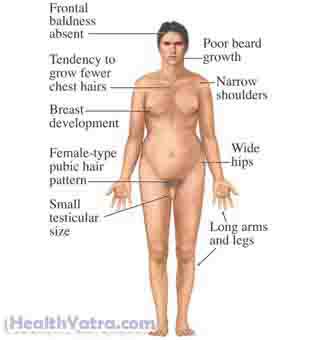Definition
Klinefelter syndrome (KS) occurs in some men who have more than one X chromosome (XXY).

Causes
Males usually inherit a single X chromosome from their mother and a single Y chromosome from their father. Males with KS get at least one extra X chromosome.
Risk Factors
A risk factor is something that increases your chance of KS. Women over age 35 have a slightly increased chance of having a child with KS. There are no other known risk factors for this disorder.
Symptoms
XXY occurs in approximately 1 out of 580 live male births, but many men with it do not develop KS. When KS does develop, it usually goes undetected until puberty or sometimes much later.
Characteristics may include:
- For babies:
- Smaller birth weight and slower muscle and motor development
- For children and adults:
- Tallness with extra long arms and legs
- Abnormal body proportions (long legs, short trunk)
- Enlarged breasts (common)
- Lack of facial and body hair
- Small firm testes, small penis
- Lack of ability to produce sperm (common)
- Diminished sex drive, sexual dysfunction
- Social and learning disabilities (common)
- Personality impairment
- Attention deficit hyperactivity disorder (ADHD)
- Normal to borderline IQ
- Speech and language problems—Children with KS often learn to speak later than other children do. They may have a difficult time reading and writing.
Men with KS have an increased risk of:
- Type 2 diabetes
- Breast cancer
- Lung cancer
- Cardiovascular disease
- Lung disease
- Osteoporosis
- Hypothyroidism
- Dental problems
- Leg ulcers
Diagnosis
A test called a karyotype is used to diagnose KS. In the case of KS, there are usually 47 chromosomes rather than the normal 46.
Many men with XXY do not know they have the condition. The diagnosis may be found:
- When amniocentesis is done
- In babies—undescended testes or very small penis
- In children—when the child is having problems learning
- In adolescents—when the child has excessive breast development
- In adults—when the man has fertility concerns
Treatment
Treatment of KS includes:
Testosterone
The main treatment is testosterone. When boys with KS are 10-12 years old, their hormone levels are checked yearly. If testosterone levels are low, then treatment may be helpful. Men diagnosed may also benefit from taking the hormone. However, testosterone cannot reverse infertility.
Testosterone is most often given through regular shots or a skin patch. The benefits include:
- Increased strength
- More muscular, male appearance
- Growth of facial and body hair
- Better self-esteem
- Modulation of mood
- Increased energy
- Increased ability to concentrate
- Greater sex drive
- Improved bone density
Speech and Language Therapy
This therapy should begin in early childhood to avoid social and school learning problems. Treatment may involve:
- Speech therapy
- Special education services
- Extra support and help with learning from parents and teachers
- Social skills training and psychological counseling
Prevention
Currently, there are no known ways of preventing KS.
